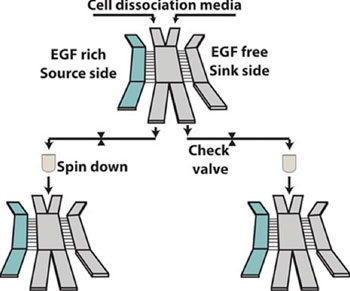Microfluidic Device Selects Cancer Cells Based on Chemotactic Phenotype
By LabMedica International staff writers
Posted on 24 Jun 2014
A new approach has been invented for screening for aggressive cancer cells, using a microfluidic device that isolates only the most aggressive, metastatic cell. Posted on 24 Jun 2014
Typically, searching for biomarkers of metastasis has focused on screening for certain molecules or genes expressed by large numbers of migrating cancer cells, but the problem is that it is easy to miss subtle differences in the tiny subpopulations of cells that are the most aggressive.

Image: Schematic design of the microfluidic device that sorts for aggressive cancer cells (Photo courtesy of Reinhart-King laboratory).
Scientists at Cornell University (Ithaca, NY, USA) first sorted cells with the most aggressive behavior, and analyze only those cells for molecular changes. Their innovation was a microfluidic device that contains side channels to wash out the less aggressive cells, while herding the more aggressive ones into a separate channel.
In the search for biomarkers of metastasis, attention has been largely placed on ensemble-averaged measurements that screen for molecules or genes. However, individual molecular changes do not always result in disease, and population-based measurements can mask the molecular signatures of the cells responsible for disease.
For their proof-of-concept, the investigators screened for cells with migratory responses to Epidermal Growth Factor, for which the receptor is known to be present in most human cancers and is tightly linked to poor prognosis. The innovative device selects for cells based on chemotactic behavior rather than based on molecular differences, enabling the most aggressive cells to be studied independently from the heterogeneous population.
Cynthia A. Reinhart-King, PhD, an associate professor of biomedical engineering and senior author of the study said, “The approach we have taken is a reverse approach from what is conventionally done. Instead of looking at what molecules are being expressed by the tumor, we are looking for the phenotype, that is, the behavior of individual cells first. Then we can determine what molecules are causing that behavior.”
Prof. Reinhart-King added, “The thing we are most excited about, in addition to the physical device, is the conceptual framework we're using by trying to shift gears and screen for cells that are causing the worst parts of the disease. The device could also be used in other applications of tissue engineering, inflammation and wound healing.”
The study was published on May 19, 2014, in the journal Technology.
Related Links:
Cornell University









 Analyzer.jpg)




